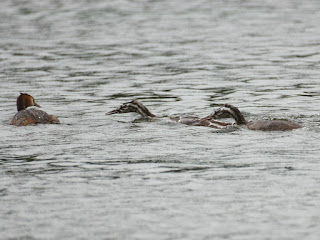In heavy rain, the Grey Heron that haunts the Dell restaurant was perched disconsolately on a table. With no one eating outside, there was no food for it to seize.
A short way along the shore, the young Lesser Black-Backed Gull was begging for food from what may or may not be its mother, the mate of the notorious pigeon-eating gull. She took no notice.
The Diana fountain enclosure, deserted by people, was full of Egyptian Geese and big gulls. This young Herring Gull found a piece of carrot, tasted it, and threw it away.
This is one of the young Egyptian Geese from the family on the north shore of the Serpentine, now almost grown up. It is drinking from a muddy puddle in the horse track, apparently better tasting than the lake water.
A flight of Canada Geese came in from the Parade Ground and settled on the lake. The second one from the left is sideslipping to lose height.
Two of the Great Crested Grebe chicks from the island were racing after their mother. They are quite big now, but will have to be fed for at least another six weeks. When they start fishing for themselves it takes them quite a time to gain the skill to find enough food.
The fearless young Pied Wagtail was running along the edge of the Serpentine, and went right past my feet.
There are also a lot of young Pied Wagtails at the Round Pond. It has been a very good year for them.
When the rain stopped and the sun came out, so did the male Little Owl. He was in the nest tree.
Mario drew my attention to this huge fungus at the top of Buck Hill, under a hazel bush next to the fence where the road divides in two. It is a Giant Polypore, Meripilus giganteus, over two feet wide.









Is this Fungus native to Britain? The colouring on it looks like mahogany. What animals would eat this? A strange fungus living in a Central London Park?
ReplyDeleteThis bracket fungus is quite common in Britain. It weakens and eventually kills the host tree. I believe that if some local councils in London find out that you have a tree in your garden next to a road infected by this fungus, they force you to cut down the tree, as it may cause the tree to fall. Usually you'll find this fungus at the base of a tree (and there are others in Kensington Gardens), but this one is on a hidden buried stump, and thus looks like a huge flower.
ReplyDeleteMario
Thanks, Mario, for answering Marie's question. I might add that the dark shiny appearance of this fungus is partly due to the fact that it was raining hard when I photographed it.
Delete